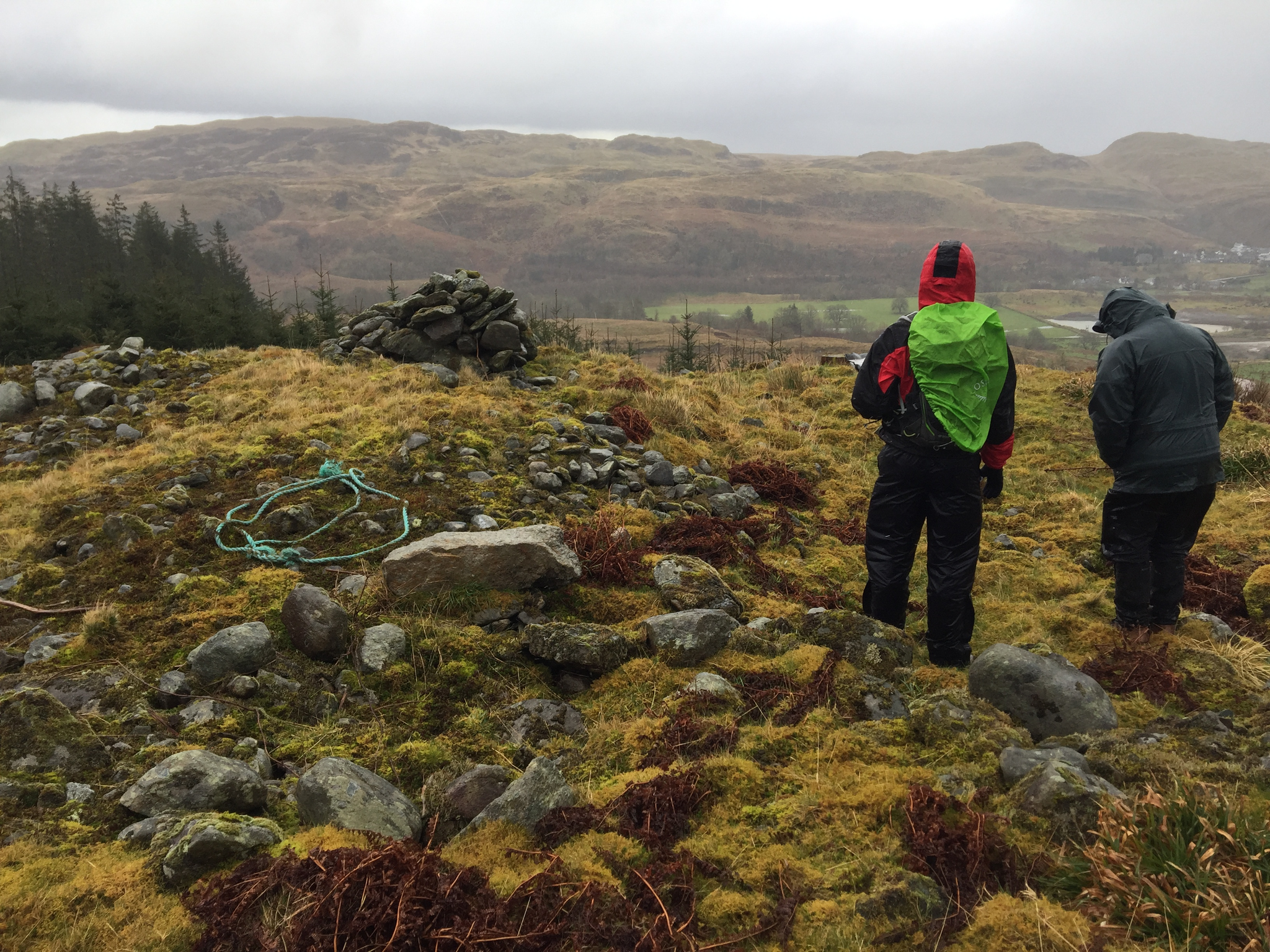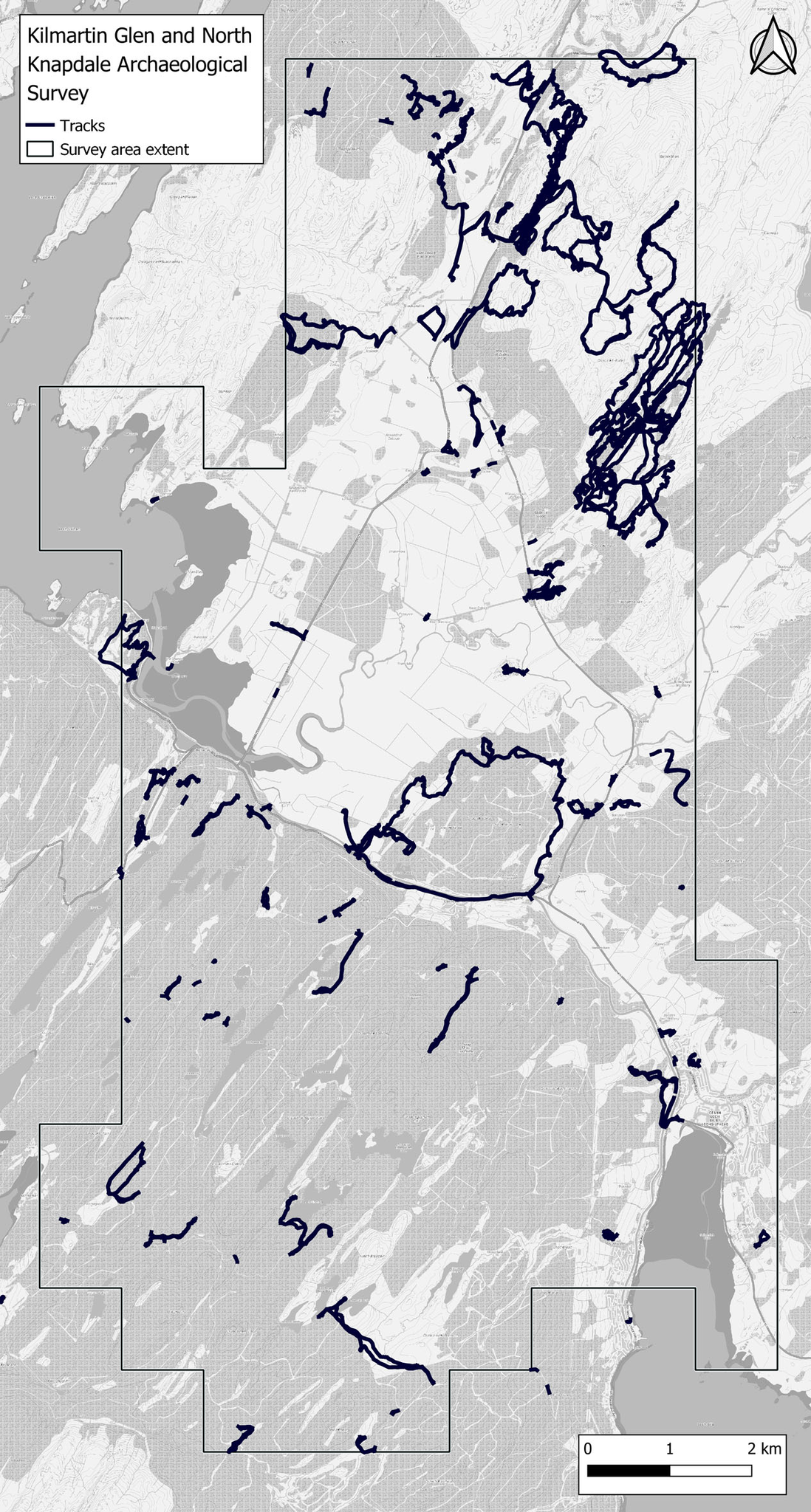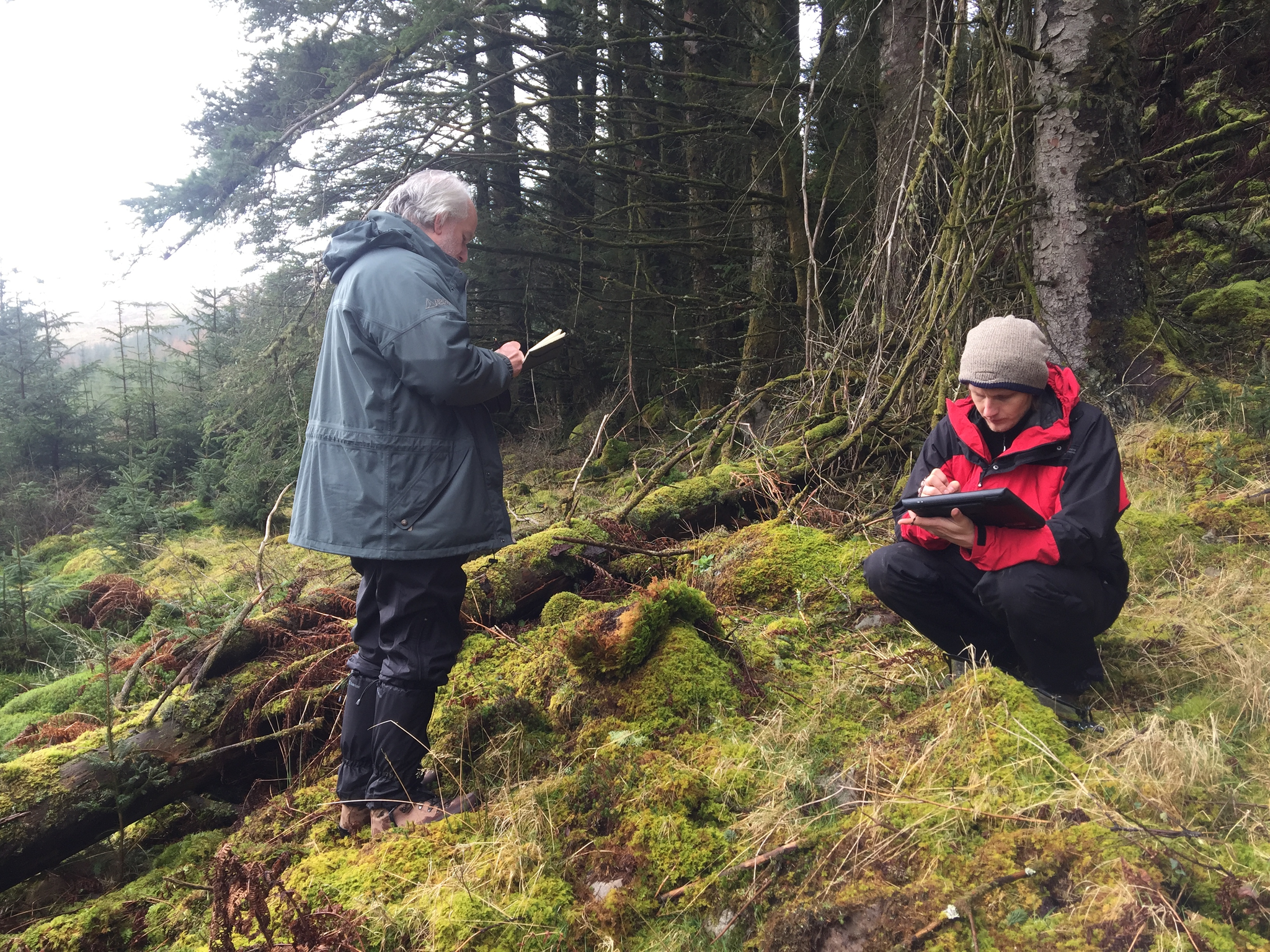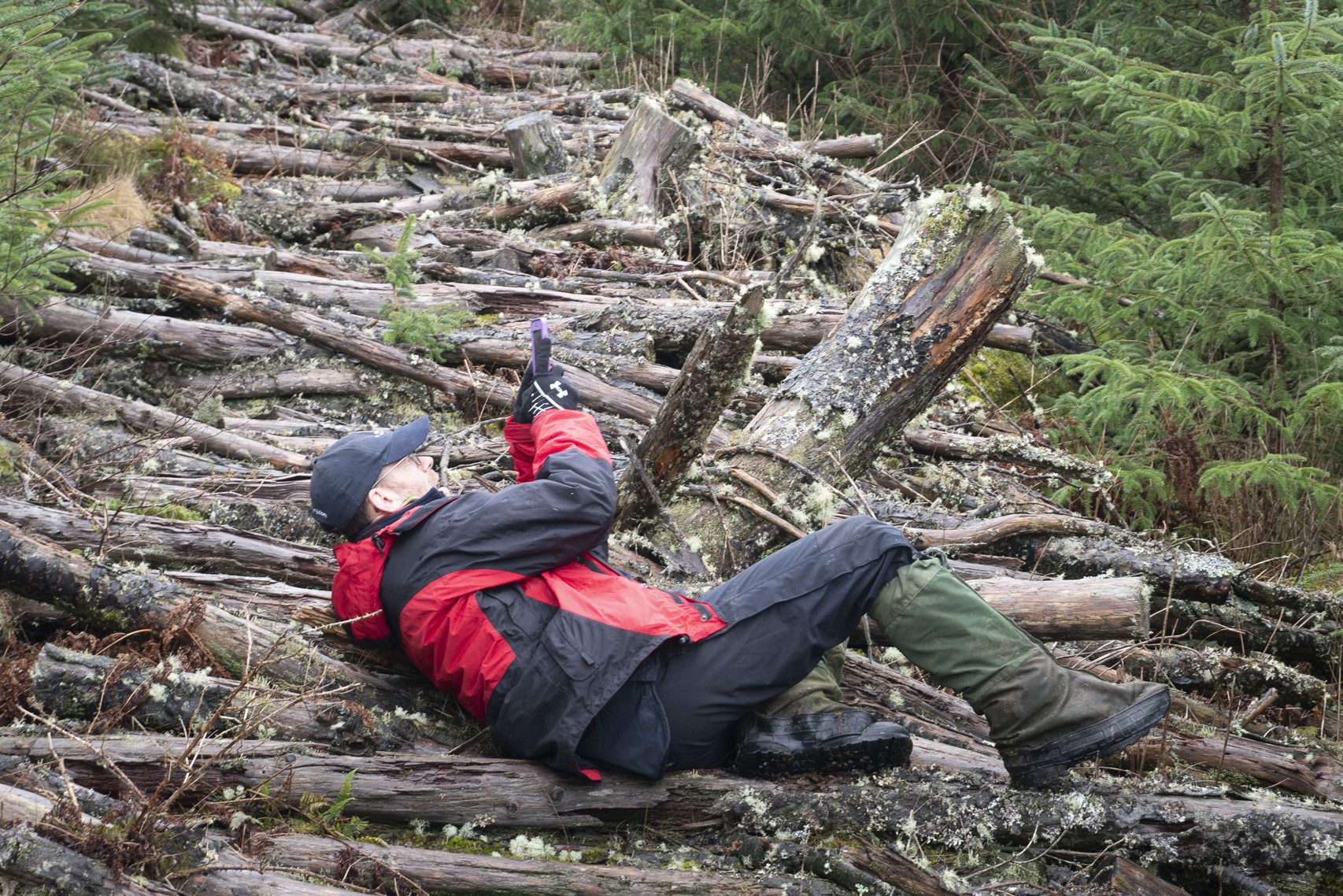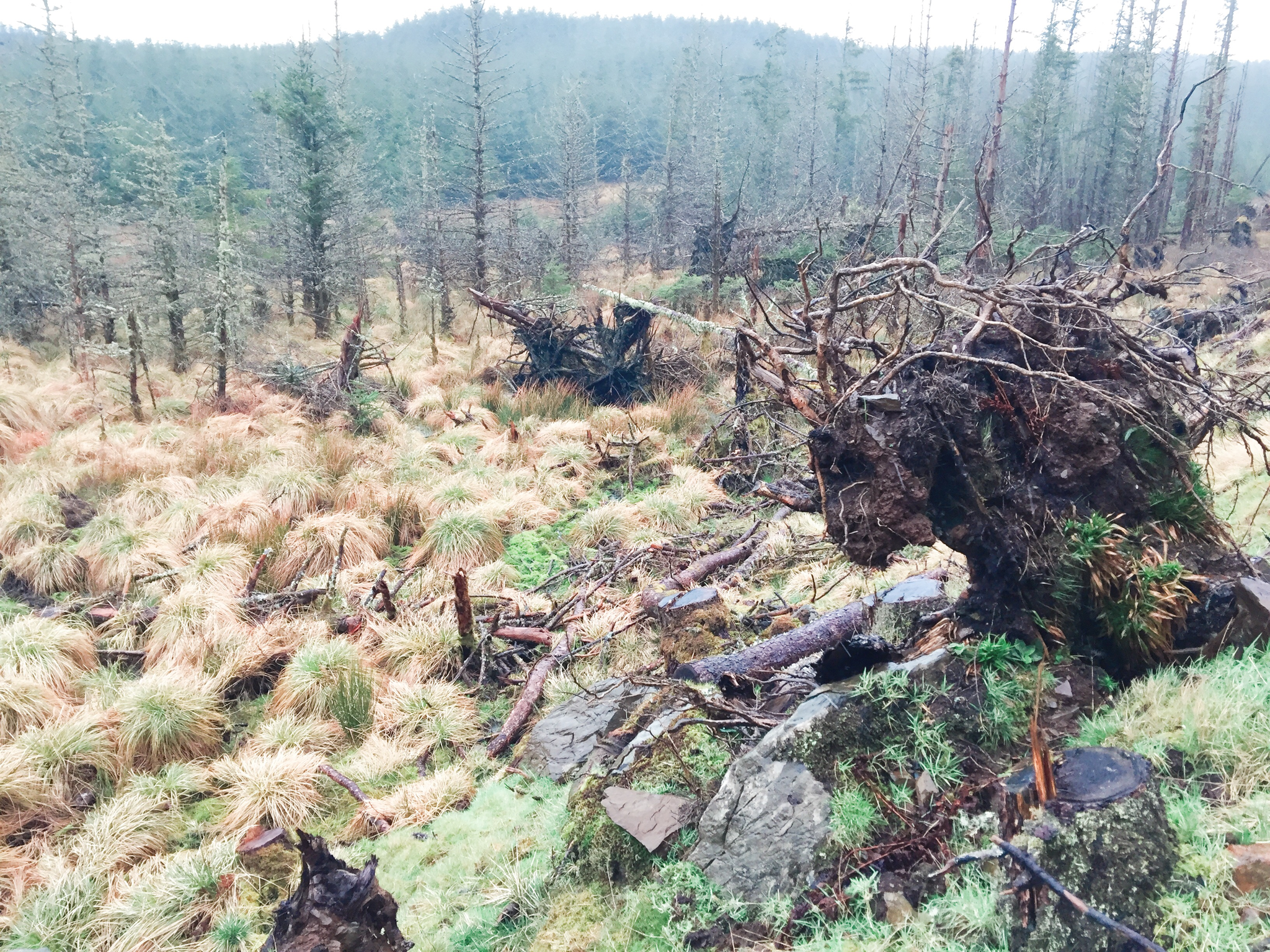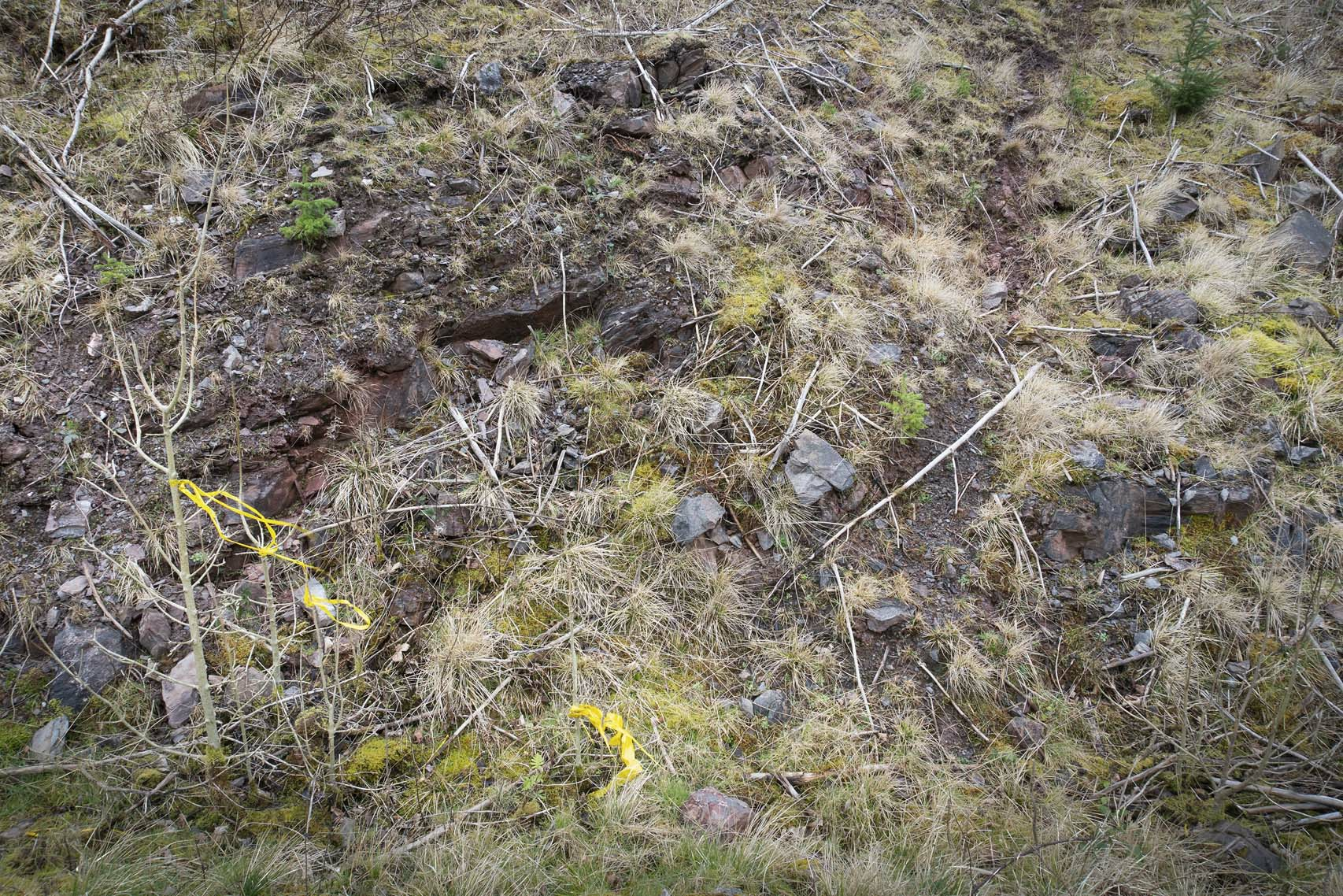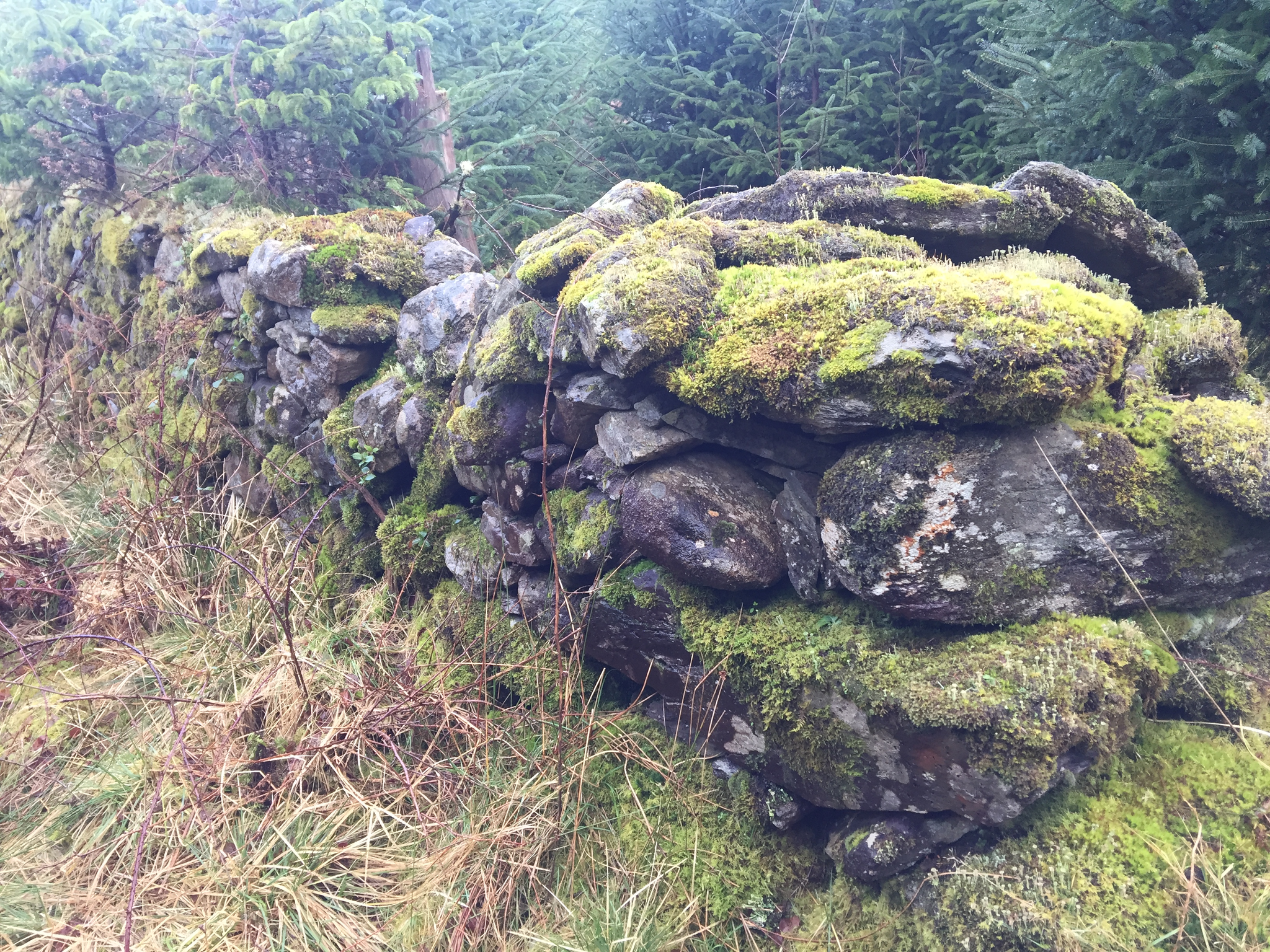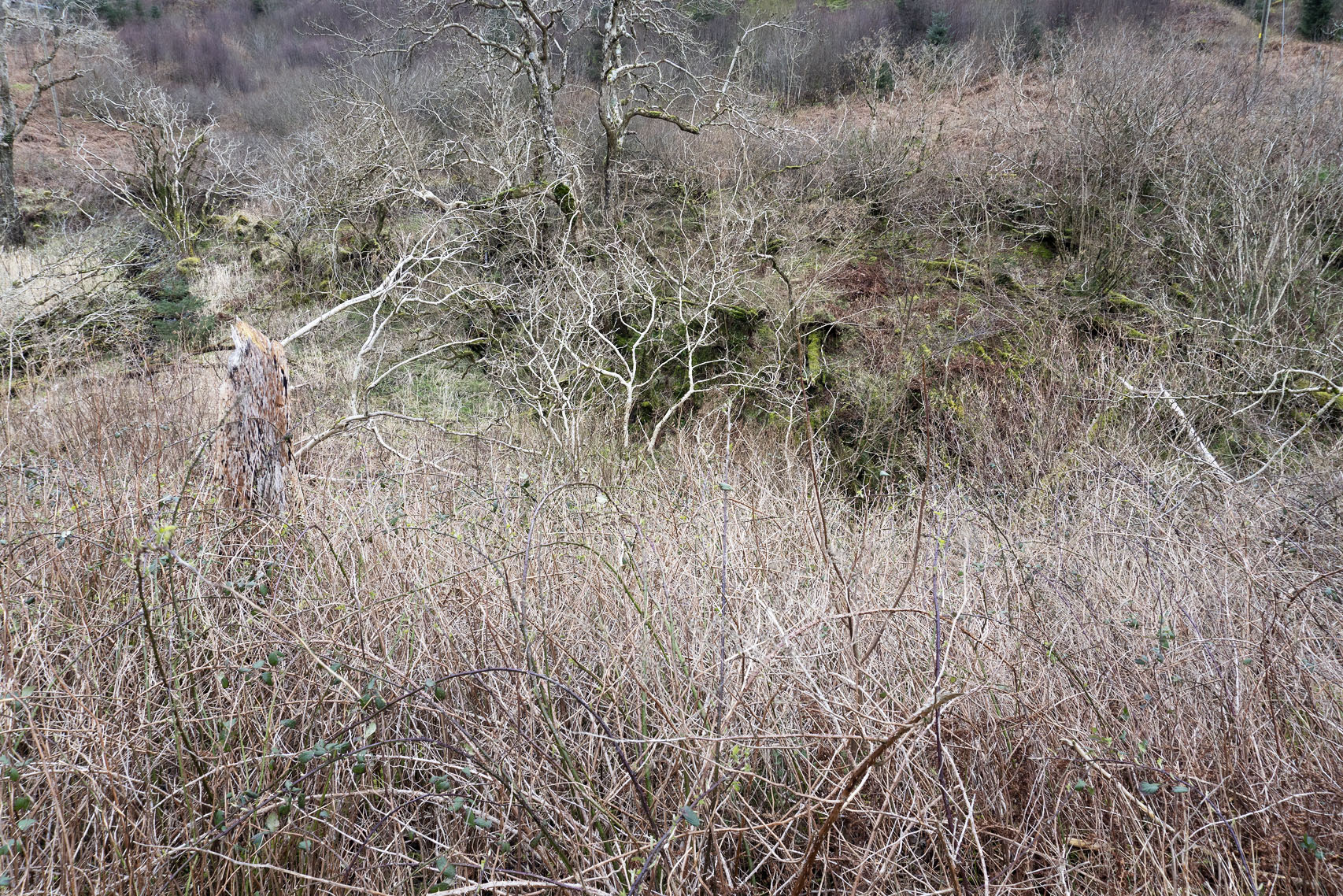The context of our own research project was that of the Kilmartin Glen research and development project of 2019 which combined LiDAR datasets with poetic action to survey and record extant surface archaeologies as part of the ongoing HES Rapid Archaeology Mapping Programme (RAMP). Part of the aims of the programme are to confirm what is in a landscape (both on the ground and through digital datasets) and draw it into a national archive, the NRHE. While acknowledging the complexities that appear through inter-disciplinary working, this approach of embedding an artist/poet into an archaeological survey team provided opportunities for critical reflection on processes, signification and interpretations through our creative assemblages of shared experiences walking the landscape, note-taking (site writing), photography and conversations on-site, and between disciplinary practitioners.
Our fieldwork in Kilmartin was conducted between 11 and 14 March 2019, and involved archaeologists from HES, along with the artist and poet, Jim Harold. The days of the survey coincided with periods of extreme weather occasioned by Storm Gareth, and conditions were, therefore, difficult and unpredictable: from rain, to sleet, high winds, and bitter cold.
The Kilmartin survey was undertaken within a research and development phase of RAMP at HES at the time of writing. The programme was instigated in 2018 with an objective to ‘explore economic and rapid methods to enrich the NRHE in ways that benefit all users […] drawing on remote sensed data’ (HES 2019a). Within it, a number of test locations have been surveyed, by applying a developing methodology that relies heavily on airborne laser scanning derivatives and orthophotographs (Banaszek et al. 2018). The remote sensing data is being utilised to demonstrate the potential for ‘identifying, recording, understanding and interpreting the historic environment’ (Cowley et al. 2020: 109) through rapid survey methods in order to provide a methodology for heritage agencies with managerial and policy responsibility for the historic environment, and it was within this context that we operated.
Specifically, the RAMP Kilmartin survey was based on two sets of high-resolution airborne laser scans covering some 110 square kilometres, alongside overlapping data covering adjacent areas in a lower resolution. The project foregrounded remote sensing and the fieldwork aimed to visit sites where there was ambiguity or a low level of confidence as to the nature of the interpretation of the digital information. The survey methodology defined specific features that would form the focus of the data-gathering (HES 2019b).
The landscape itself, while not forming a documented part of the RAMP survey beyond any topographic positioning, was navigated and, in many senses, negotiated with. The glaciated glen that leads up from Lochgilphead and the Mòine Mhòr drifts from peat bog into farmland while the hills, rising to some 450m, are densely planted with commercial forestry. Rainfall drains from these hills, down into the River Add, and then out to the Sound of Jura and the sea. Over the three days of our fieldwork, we were mainly searching targets within the forestry lands. Beginning each day in proximity to the Kilmartin Museum, a temporary base and re-grouping point, before travelling south and west to the trapped valleys close to Crinan – our first day – and north and west on the following days into the high woodlands. Here, densely planted Sitka Spruce forestation made movement difficult, as did areas of logging – some recent – where brash, stumps and deep vehicle ruts effected a landscape that closely resembled a battleground. Yet, within this land, small events of some beauty still resonated. There were clumps of primroses along with other small spring plants whose brightness eased the desolation. As did the birds and their song, robins and the many small brown birds, snipe and osprey too, and the distant calls from the Add estuary. Mammals and insects made their presence known, from the smallest deer tick, to a darting bank vole living among a group of post-Medieval clearance cairns, to a fine hind paused just beyond an early head dyke at a woodland edge.
Our response to the current evolving RAMP research – as archaeologist and artist/poet coalesced – was through performative and embodied experience. This was achieved by situating the fieldwork experiences and imaginal connections into a richer field of fluid meanings and language forms, as evidenced in this paper through a range of practices. Given the vast landscape scale of the RAMP research and the absence of collectable artefacts, it was inevitable that these various modes of language documentation were to become our artefacts.
We began our own survey within a fluid exploration that aimed to reflect our particular disciplines and the necessary demands of applying our techniques on a landscape scale. We embraced the opportunities for critical reflection on processes – an opportunity to consider practices that are taken for granted – signification and meaning/interpretation through our creative assemblages of shared experiences walking the landscape, note-taking and site writing (Rendell 2006), photography, conversations, and sustained dialogue on-site, and between our respective disciplines (c.f. Pearson and Shanks 2001; Shanks 2012).
We allowed encounters and discussions in the field, followed by later periods of reflection, analysis of our results, and questions that would shape our future approaches. This was moulded increasingly through dialogue before, during, and after fieldwork and within the context of the recently expanded Art and Archaeology creative practices (Thomas et al. 2017; Russell and Cochrane 2014; Bailey 2014, 2017). This unfolding development of our research has not reached a conclusion and doesn’t aim to, rather its purpose is to provide a complementary approach to RAMP and other contemporary landscape-scale archaeological survey and mapping projects (Lee 2018; Coppes and Lee 2018; Palsson and Aldred 2017; Pearson 2017; Gillings et al. 2018; Cohen and Duggan 2021).
With spade, trowel and total station set aside, and with no physical objects actually collected, we considered how experience might usefully affect, open, and re-wild the language of the inventory. The digital files become text, image, and archive: our only reclaimed artefacts for a national record. We also dissected how our shared practices in dialogue might significantly expand the documented and archived experience of the few days spent at Kilmartin. Whether, too, this form of art/archaeology can achieve an expanded, landscape-scale entanglement. How in effect might site walking, site writing, dialogue en-route coupled with the phenomenological experience add to a more encompassing picture of a space that embraces place, time and the poetic, a ‘deep map’ of the landscapes and their potential (Heat Moon 1991: i)? And how might this create, in the process, a series of works as reflections that lie within, but also move beyond, the academically defined boundaries of either art or archaeology: a mutual working together that seeks to usefully (not wilfully) disarticulate, repurpose and disrupt conventions of meaning (Bailey 2017)? The ‘reductive duality’ [1] of a ‘truth’, the analytic site-document, for example, versus a non-scientific, romanticised or poetic depiction of place was challenged to illustrate how truth and poetry may be shown to reside within the disciplinary languages of both specialisms. Through our chosen approach to blending evidence with expression, we hoped to produce a work that would suggest humanity’s toe-hold on the landscape as a fluid thing. A toe-hold or trace that acknowledges both a presence and an absence without fixed (or immutable/formalised) links between the past, tradition and the contemporary space of meanings. This exposition, therefore, reflects our individual practice through writing, and the qualities of image and text as image, with the overall design and layout of the exposition illustrating our commonalities and the margins of our individual practices.
A Wilding of the Word through Actions
As our practices unfolded during fieldwork and post-fieldwork meetings, a place developed within our respective disciplinary margins which at first seemed small, yet fertile. Since the fieldwork, during discussions, drafting texts and taking food together, potential ideas grew within this marginal space to reveal a necessity for our practice to free the text, language, and meaning of the inventory within and beyond the national archive. During our discussions, it became clear, too, that we must acknowledge and, in some small way, incorporate current discussions and actions designed to consider the deep structural issues that both archaeology and other disciplines have recognised and are addressing, such as gender (Moser 2007), photography and imperial legacies (Azoulay 2019), and acts of colonial violence (Hicks 2020). In its own part, fieldwork can be seen as an extension of military subjugation through survey and mapping practices previously applied to repress local populations. Specifically, and in connection with ongoing photographic and LiDAR-driven surveys, we recognise that these approaches can be applied beyond their original purposes and through critical reflection, with the intention of positively and sensitively expanding our relationships with landscape, place, each other and more-than-humans.
On reflection of the physical landscape of Kilmartin Glen, our observations of commercial forestry, farmland and rough grazing lands, and combined experience led to talk of ‘wild’, ‘tamed’, ‘domesticated’, and ‘devastated’ topographies. But it was after our departure from the landscape that we began to surface the potential for re-wilding, not in the scientific, nature conservation sense (cf. Lorimer et al 2015), nor within the contexts of how archaeological remains are being considered within the re-wilding agenda of landscape management (DeSilvey and Bartolini 2019). Rather, ours is an attempt to surface, explore and to reflect on the multi-scalar potential of wildness across landscapes, both topographical, linguistic, and imaginary.
In this way, we recognise the need for a wilding of language in the archive that allows for and encourages a re-imagining both of archaeological landscapes and of the poetry of landscapes: one that steps beyond any reductivism, consequent upon the traditional condensation of language in the terms of categorisation and inventory. In effect, a stratagem that seeks to engender a dynamic and fluid sense of language, its value within the world and to knowledge systems, that reflects its formative state as a ‘raw and primitive being’ (Foucault 1970: 42) and its elusive meaning(s) arising from ‘the silent origin of word and thing’ (Haase and Large 2001: 60) – not a domesticated or fixed thing, but a living and vital form of continual enactment, mirroring the world of natural phenomena.
‘We think we know what to expect from the world we live in and miss the opportunity to see things not only for what they are but also for what they are becoming. New worlds open up every day, [Italo] Calvino observed, and we fail to notice them’ (Farrier 2020: 152).
The Kilmartin survey’s remit, as already noted, was not to collect physical artefacts, but to focus instead on the written or digitised word, the grid reference and the confirmation or not of a find. This opened a door for an analysis of the comparative use and value of languages and media within the context of a survey and the archive. Where many other Art/Archaeology projects have focused on the material (the object/artefact), our research explored the phenomenological experience and language as artefact: a signification and chance to wild – maybe also to ‘weird' (Morton 2016: 5) – things that in many senses are being domesticated towards a form of extinction. As such, and following the broader research project’s remit, we focused on the use of language as a means of both a description of experience and of scientific data – poetic form and document.
In effect, we considered the potential of the different scales of entanglement that are explicit and implicit in a survey like that at Kilmartin Glen and, by projection, any similar survey. In the process, we have sought to identify and value those qualities that may be found within and between the intertwining scales and entanglements of language as they are adopted by the survey and the poetic, whether presented as text or as image and in the terms of place. Not, however, a fixed sense of place, but a place like that indicated earlier in this text by Lyotard, or more recently by Morton, as both a fluid series of events (Lyotard) that are freed of any ‘reliable constancy' (Morton 2016: 5). A place of movement, intersections, scalar diversity and signification. A place, many places at once, that may be found equally within the environments of the archive and the landscape: within the word, on the page, at one’s feet, under a rock, amongst the undergrowth, beneath the earth, in the document, in the poem, before one’s eyes, in a sound, in the instant, in the multi-valency of place and places. In this regard, place – like words and poetry, bends and twists (Morton 2016: 11) – folds and unfolds to reveal its intrinsic otherness. Lists, such as those we are using in these concluding thoughts, neither act as hierarchical, nor linear entities, but as loops. The wilding of language revealing an otherness – the ruin within language – as it enters the archive that is devoted to the discovery of and articulation of the ruin.
The acknowledgement of the role of language as a significant locus for the wilding of meaning opens up the possibility to re-appraise how experiences and our worldview are shaped in relation to landscape, archaeology, and art. The concept of wilding demonstrably expands the possibilities of the idea of place and places, rather than closing them down. It quite simply allows us to see things differently and strangely. For the authors, the idea, sensation and experience of place – not space which can be both conceptually and physically colonised – is such that it contains both the experience of our meaning(s) and their otherness. As our research has developed we have begun to consider that there is a further potential expansion of the concept of a wild or wilded language which we consider might be termed as a ‘feral language’. This is a mode of expression that steps further away from any comfort zone that might normally be made possible by our conventional or domesticated usage and acceptance of language (Harold 2020) to engender a further and more nuanced state of estrangement for the participant (Wall and Hale 2020). We became familiar and comfortably uncomfortable through our collaborative practice during the fieldwork and as a result of subsequent calls, meetings and research. As such, the drifting form(s) of a wild become feral practice and language acts like a mesh of relations and indicators and, by so doing, alters our scales of reference from the smallest thing and word to the largest scale: from word to sentence, to paragraph, to essay, chapter or book.
In conclusion, it is in this spirit that we consider our future entanglements should move between the differing scales of engagement, from the material constituents of the archive (the word, the document, folio, acid-free box, the shelf and the institution) to that of the landscape, with its close details (the undergrowth, the site, vague structures, the ruin, etc.). A matter of breathing inwards and outwards towards the larger parameters that are defined by geology, landscape, land-use patterns, the horizon line, or the overarching weather systems. Within our collaboration, we consider our practices to actively expand our disciplines which, at times, we hope can be constructively provocative. We shall continue to identify and contrast a select number of locations that cover a range of sites from the historical to expanded forms of heritage and new heritage sites in terms of the complexities of language, description, and the environment. Such surveys allow for the potential to engage further with curious confabulations, and human and non-human entanglements, through tentacular processes, practices and chance.


